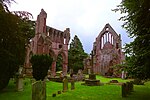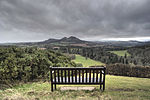Statue of William Wallace, Bemersyde

The William Wallace Statue near the grounds of the Bemersyde estate, near Melrose in the Scottish Borders is a statue commemorating William Wallace. It was commissioned by David Steuart Erskine, 11th Earl of Buchan, and it protected as a category B listed building.The statue was made of red sandstone by John Smith of Darnick and was erected in 1814. It stands 31 feet (9.4 m) high and depicts Wallace looking over the River Tweed. In 1991, the William Wallace Trust ,which owns the statue and surrounding land and car park raised funds for a renovation which was carried out by Bob Heath and Graciella Glenn Ainsworth. At Wallace's feet reads the inscription: Below the statue of Wallace, as part of the same construction by John Smith is a smaller statue of a funeral style urn inscribed as follows: Close by are Brotherstone Hill, Dryburgh Abbey, the Leaderfoot Viaduct, Newtown St. Boswells, Scott's View, and the Smailholm Tower.
Excerpt from the Wikipedia article Statue of William Wallace, Bemersyde (License: CC BY-SA 3.0, Authors, Images).Statue of William Wallace, Bemersyde
B6356,
Geographical coordinates (GPS) Address Nearby Places Show on map
Geographical coordinates (GPS)
| Latitude | Longitude |
|---|---|
| N 55.5862 ° | E -2.6495 ° |
Address
B6356
TD6 0RQ
Scotland, United Kingdom
Open on Google Maps










